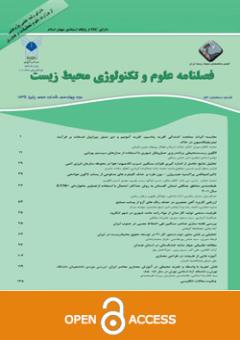Synthesis and application of EDTA modified Graphene nano-hybrid in the removal of heavy metals and methylene blue from water
Subject Areas : Environment Pullotion (water and wastewater)Seyed Mohammad Khadivi 1 , ladan Edjlali 2 * , Abolfazl Akbarzadeh 3 , Kambiz Seyyedi 4
1 - Ph.D student, Department of Chemistry, Tabriz Branch, Islamic Azad University, Tabriz, Tabriz.Iran.
2 - Associate Professorof Organic Chemistry, Department of Chemistry, Tabriz Branch, Islamic Azad University, Tabriz,Tabriz, Iran. * (Corresponding Author)
3 - Associate Professor of Pharmaceutical Chemistry, Department of Medical Nanotechnology, Faculty of Advanced Medical Science, Tabriz University of Medical Sciences. Tabriz, Iran..
4 - Assistant Professor of Applied Chemistry, Tabriz Branch, Islamic Azad University, Tabriz, Tabriz, Iran.
Keywords: Graphene Oxide, EDTA, Nano Absorbent, Methylene Blue, Heavy metal.,
Abstract :
Background and Objective: In this study, we compared the efficiency of pure GO (Graphene oxide) and GO modified with EDTA as an absorber for methylene blue and some heavy metals such as copper, lead, and arsenic. Regarding the structural properties of EDTA, we expected that after attaching EDTA to GO, the effect of modified GO in adsorption of pollutants, increased. Based on the characteristics of synthesized nanohybrid, methylene blue (MB) absorbed through interactions with GO levels through π-π interaction, as well as electrostatic interactions with EDTA. Heavy metals adsorbed to modified GO by forming a complex compound.
Material and Methodology: X-ray powder Diffraction (XRD), Scanning Electron Microscope (SEM), Fourier Transform Infrared Spectroscopy (FT-IR), UltraViolet-Visible Spectroscopy (UV-Vis) were approved.
Findings: 0.03 grams of synthesized modified GO eliminated 30 ml of contaminants at a concentration of 1 g/l in the first 30 minutes.
Discussion and Conclusion: The results show high removal efficiency in the first 30 minutes witch that confirming the effect of modified GO on color removal efficiency.
1. Fu F, Wang Q (2011) Removal of heavy metal ions from wastewaters: a review. Journal of environmental management 92 (3):407-418.
2. Li X, Zhou H, Wu W, Wei S, Xu Y, Kuang Y (2015) Studies of heavy metal ion adsorption on Chitosan/Sulfydryl-functionalized Graphene oxide composites. Journal of colloid and interface science 448:389-397.
3. Jaishankar M, Tseten T, Anbalagan N, Mathew BB, Beeregowda KN (2014) Toxicity, mechanism and health effects of some heavy metals. 7 (2):60. doi:https://doi.org/10.2478/intox-2014-0009
4. Meshitsuka S, Ishizawa M, Nose T (1987) Uptake and toxic effects of heavy metal ions: interactions among cadmium, copper and zinc in cultured cells. Experientia 43 (2):151-156.
5. Sud D, Mahajan G, Kaur M (2008) Agricultural waste material as potential adsorbent for sequestering heavy metal ions from aqueous solutions–A review. Bioresource technology 99 (14):6017-6027.
6. Ngah WW, Hanafiah M (2008) Removal of heavy metal ions from wastewater by chemically modified plant wastes as adsorbents: a review. Bioresource technology 99 (10):3935-3948.
7. Shahzad A, Miran W, Rasool K, Nawaz M, Jang J, Lim S-R, Lee DS (2017) Heavy metals removal by EDTA-functionalized chitosan Graphene oxide nanocomposites. RSC Advances 7 (16):9764-9771.
8. Ge F, Li M-M, Ye H, Zhao B-X (2012) Effective removal of heavy metal ions Cd2+, Zn2+, Pb2+, Cu2+ from aqueous solution by polymer-modified magnetic nanoparticles. Journal of hazardous materials 211:366-372.
9. Da̧browski A, Hubicki Z, Podkościelny P, Robens E (2004) Selective removal of the heavy metal ions from waters and industrial wastewaters by ion-exchange method. chemospHere 56 (2):91-106.
10. Qdais HA, Moussa H (2004) Removal of heavy metals from wastewater by membrane processes: a comparative study. Desalination 164 (2):105-110.
11. Ozaki H, Sharma K, Saktaywin W (2002) Performance of an ultra-low-pressure reverse osmosis membrane (ULPROM) for separating heavy metal: effects of interference parameters. Desalination 144 (1-3):287-294.
12. Shi-Jia M, Yu-Chang S, Li-Hua X, Si-Dong L, Te H, Hong-Bo T (2013) X-ray difraction pattern of grapHite oxide. Chinese PHysics Letters 30 (9):096101
13. Tuzen M, Saygi KO, Soylak M (2008) Solid pHase extraction of heavy metal ions in environmental samples on multiwalled carbon nanotubes. Journal of Hazardous Materials 152 (2):632-639.
14. Camacho, L.M., et al. (2010), Adsorption equilibrium and kinetics of fluoride on sol–gel-derived activated alumina adsorbents. Journal of colloid and interface science,. 349(1): p. 30.
15. Bradder, P., et al.,. (2010), Dye adsorption on layered grapHite oxide. Journal of Chemical & Engineering Data, 2010. 56(1): p. 138-141.
16. Liu, T., et al.. (2012), Adsorption of methylene blue from aqueous solution by Graphene. Colloids and Surfaces B: Biointerfaces. 90: p. 197-20

